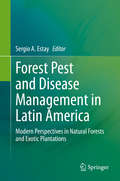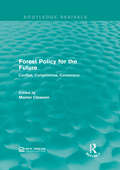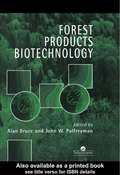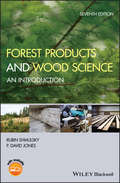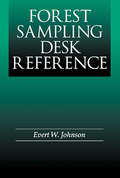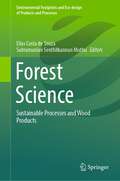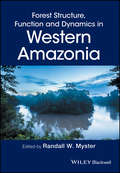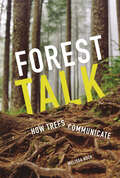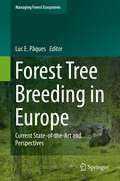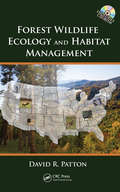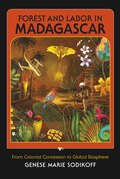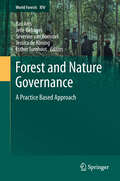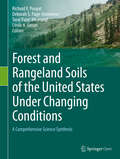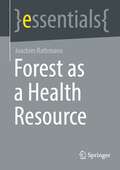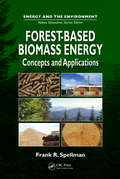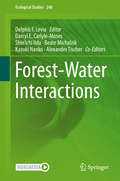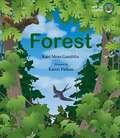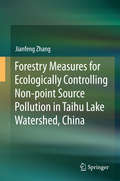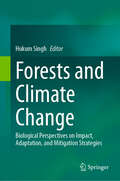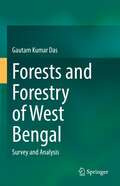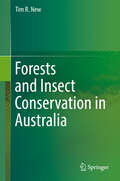- Table View
- List View
Forest Pest and Disease Management in Latin America: Modern Perspectives in Natural Forests and Exotic Plantations
by Sergio A. EstayBy providing multiple economic goods and ecosystem services, Latin American forests play a key role in the environmental, social and economic welfare of the region’s countries. From the tropical forests of Central America to the Mediterranean and temperate vegetation of the southern cone, these forests face a myriad of phytosanitary problems that negatively impact on both conservation efforts and forest industry. This book brings together the perspectives of several Latin American researchers on pest and disease management. Each chapter provides modern views of the status and management alternatives to problems as serious as the impact of introduced exotic insects and diseases on Pinus and Eucalyptus plantations throughout the continent, and the emergence of novel insect outbreaks in tropical and temperate native forests associated with global warming. It is a valuable guide for researchers and practitioners working on forest health in Latin America and around the world.
Forest Policy for the Future: Conflict, Compromise, Consensus (Routledge Revivals)
by Marion ClawsonThe use and management of forests in the United States, especially the public owned ones, have been the focus of considerable controversy. First published in 1974, this volume, a collection of papers originally delivered at the RFF Forest Policy Forum, explores alternative forest management programmes to see what is biologically, economically, socially and politically possible. This title is a valuable resource for students interested in environmental studies, as well as for policy makers.
Forest Preservation in a Changing Climate: REDD+ and Indigenous and Community Rights in Indonesia and Tanzania
by Sébastien JodoinThis book provides a comprehensive socio-legal examination of how global efforts to fight climate change by reducing carbon emissions in the forestry sector (known as REDD+) have affected the rights of Indigenous Peoples and local communities in developing countries. Grounded in extensive qualitative empirical research conducted globally, the book shows that the transnational legal process for REDD+ has created both serious challenges and unexpected opportunities for the recognition and protection of indigenous and community rights. It reveals that the pursuit of REDD+ has resulted in important variations in how human rights standards are understood and applied across multiple sites of law in the field of REDD+, with mixed results for Indigenous Peoples and local communities in Indonesia and Tanzania. With its original findings, rigourous research design, and interdisciplinary analytical framework, this book will make a valuable contribution to the study of transnational legal processes in a globalizing world. This title is also available as Open Access. Explores the opportunities as well as the challenges that REDD+ has created for the protection of human rights in developing countries. Provides comprehensive analysis of the implications of REDD+ for the rights of Indigenous Peoples and local communities. Original findings developed through extensive fieldwork provide new insights for those working on the intersections of REDD+ and rights.
Forest Products Biotechnology
by Alan Bruce John W. PalfreymanIndustries are developing radical, new biotechnology processes to expand and develop their range of products that originate from the world's forests. As a result of the growing understanding of the process involved, biotechnology is also helping reduce any adverse impact on the environment.; This book presents a review of specialist research direct
Forest Products and Wood Science: An Introduction
by Rubin Shmulsky P. David JonesThe updated seventh edition of the classic text on wood science and forestry The seventh edition of Forest Products and Wood Science: An Introduction offers a fully revised and updated review of the forest products industry. This classic text contains a comprehensive review of the subject and presents a thorough understanding of the anatomical and physical nature of wood. The authors emphasize its use as an industrial raw material. Forest Products and Wood Science provides thorough coverage of all aspects of wood science and industry, ranging from tree growth and wood anatomy to a variety of economically important wood products, along with their applications and performance. The text explores global raw materials, the increasing use of wood as a source of energy and chemicals and environmental implications of the use of wood. This edition features new material on structural composites, non-structural composites, durability and protection, pulp and paper, energy and chemicals, and global raw materials. This seventh edition of the classic work: Contains new information on a variety of topics including: structural composites, non-structural composites, durability and protection, pulp and paper, energy and chemicals and global raw materials Includes a fully revised text that meets the changing needs of the forestry, engineering, and wood science academics and professionals Presents material written by authors with broad experience in both the private and academic sectors Written for undergraduate students in forestry, natural resources, engineering, and wood science, as well as forest industry personnel, engineers, wood-based manufacturing and using professionals, the seventh edition of Forest Products and Wood Science updates the classic text that has become an indispensable resource.
Forest Radioecology in Fukushima: Radiocesium Dynamics, Impact, and Future
by Shoji Hashimoto Masabumi Komatsu Satoru MiuraThis is an open access book that provides holistic information on the radioactive contamination of forests. Topics are highly interdisciplinary, ranging from the dynamics of radioactive cesium in forest ecosystems to the radiation protection or the socio-economic aspects of radiation effects. It is designed to help people understand the radioactive contamination in forests and provide hints of how to cope with it and restore their livelihoods. The book is characterized by its well-balanced structure that allows the reader to understand the whole picture without going into too much scientific content. After explaining the basics of radioactive materials and radiation, the book illustrates the radioactive contamination of forests, it also describes the impacts on the forestry and life of local people and the measures taken by. Few books address the concerns about how to deal with radioactive contamination of forests and the future perspectives. In this book, people can learn all about the Fukushima nuclear accident of forests, forest products, and people with abundant reference materials. In addition, the book contains four memoirs contributed by Japanese and European researchers that graphically record what the researchers thought and how they acted in the chaos of the aftermath of the accident. In 2021 that marking the 10th anniversary of the Fukushima nuclear accident and the 35th anniversary of the Chernobyl accident, nuclear disasters are in the spotlight more than ever. This thought-provoking book on how to prepare for a severe nuclear accident is suitable for sharing with people all over the world as a lesson on the next nuclear accidents, now that the number of nuclear power plants is still increasing. The translation of this work was done with the help of artificial intelligence (machine translation by the service DeepL.com). Intensive improvements were subsequently made by the authors throughout the text to ensure accuracy of expression and contents and to enhance the clarity.
Forest Sampling Desk Reference
by Evert W. JohnsonShould damaged trees be clear cut and replanted or allowed to recover naturally? Is the deer herd large enough to survive hunting pressure? Managing forest resources entails numerous decisions. Making these decisions intelligently requires sound information about the resource in question. Ideally, assessments should be based on the entire populatio
Forest Science: Sustainable Processes and Wood Products (Environmental Footprints and Eco-design of Products and Processes)
by Subramanian Senthilkannan Muthu Elias Costa de SouzaThis book highlights the sustainability aspects of products and processes in forest science. The forest products sector supplies raw materials to several industrial sectors worldwide. These products can be classified as timber or non-timber products. Wood products are those that originate from the woody fraction and can include pulp, charcoal, firewood, and others. The non-timber products, on the other hand, have the products extracted from the different parts of the tree, such as bark, leaves, fruits, resins, oils, tannins, or even products extracted from non-woody biomass, such as palm heart or carnauba, among others. There are new studies and new products developed from forests worldwide each day. However, studies that evaluate the sustainability of these products and the processes related to their production are not so common. It is essential to highlight the sustainability aspects of these activities and the products obtained from them; such that steps can be taken to make the processes eco-friendly. Allied to ecological sustainability studies that evaluate the technical and economic feasibility of such activities arise. With this book, the authors through the approach of other products and processes of forest science, present the practical vision of aligning production with sustainability in an economically viable way. The book analyses different products and processes, ranging from technological production of engineered wood products to handcrafted resins with a high commercial appeal. With the expertise of different authors, who are researchers in various specific areas of forest sciences, this book helps expand research and presents new insights, assisting industry decision-makers and researchers working in the areas forest sciences.
Forest Structure, Function and Dynamics in Western Amazonia
by Randall W. MysterThe Amazon Basin contains the largest and most diverse tropical rainforest in the world. Besides the Andes and the Atlantic Ocean, the rainforest is bounded to the north by the Guiana crystalline shield and to the south by the Brazilian crystalline shield, marked at their edges by cataracts in the rivers and often dominated by grasslands. This book is motivated not just by the Amazon's scientific interest but also by its role in many ecosystem functions critical to life on Earth. These ecosystems are characterized both by their complexity and their interactive, higher-order linkages among both abiotic and biotic components. Within Amazonia, the Western Amazon (west of 65° latitude) is the most pristine and, perhaps, the most complex within the Amazon Basin. This Western Amazon may be broadly divided into non-flooded forests (e.g. terra firme, white sand, palm) and forests flooded with white water (generally referred to as várzea) and with black water (generally referred to as igapó). Here, for the first time, is a book devoted entirely to Western Amazonia, containing chapters by scientists at the forefront of their own areas of expertise. It should be a valuable resource for all future researchers and scholars who venture into Western Amazonia, as it continues to be one of the most beautiful, mysterious, remote and important ecosystems on Earth.
Forest Talk: How Trees Communicate
by Melissa KochTrees are essential. They provide water, shelter, and food for millions of plant and animal species, including humans. They deliver proven health benefits, and they capture and store carbon, which combats climate change. Yet trees are in trouble. Forests are struggling to adapt to climate change, and deforestation is a major threat. Recently, researchers and citizen scientists made the surprising revelation that trees communicate with each other through an underground system of soil fungi and other methods. Complex social networks help trees survive and thrive by transferring resources to each other, sending defense signals, communicating with their kin, and more. Meet the tree scientists and learn more of their fascinating discoveries.
Forest Tree Breeding in Europe: Current State-of-the-Art and Perspectives
by Luc E PâquesForest tree breeding has been ongoing for more than 70 years across Europe. It has successfully generated improved varieties for the major economical forest tree species. They are part of the present European forestry landscape and largely contribute to intensive wood production and other forest activities. In this book, we describe the state-of-art of breeding for the main forest tree species. We provide a comprehensive, unique and up-to-date overview of the major scientific results and breeding achievements gathered from the many programmes scattered across Europe. The book is divided into 10 chapters, each as a monograph corresponding to a species or group of species Abies spp., (Larix spp., Picea abies, Picea sitchensis, Pinus sylvestris, Pseudotsuga menziesii, and Mediterranean pines; Acer pseudoplatanus, Fraxinus excelsior, and Prunus avium). Each of them is written by a group of experts and focuses on the distribution and economical importance of the species; motivation for breeding and breeding objectives; intraspecific genetic variability, breeding populations and breeding strategy; forest reproductive material deployment including mass-propagation and, prospects and perspectives for joint research and breeding. The book is a unique and up-dated source of information for students, researchers and professionals interested in the genetics and domestication of forest tree species.
Forest Wildlife Ecology and Habitat Management
by David R. PattonAcross the continental United States, one can identify 20 distinct forest cover types. Most of these are to be found on federal lands managed by the U.S. Forest Service and Bureau of Land Management. Those responsible for the management of trees that form the 20 different cover types and the diversity of forest wildlife that reside in them must hav
Forest and Labor in Madagascar: From Colonial Concession to Global Biosphere
by Genese Marie SodikoffA study of the demands of economic development and ecological conservation on the African island country.Protecting the unique plants and animals that live on Madagascar while fueling economic growth has been a priority for the Malagasy state, international donors, and conservation NGOs since the late 1980s. Forest and Labor in Madagascar shows how poor rural workers who must make a living from the forest balance their needs with the desire of the state to earn foreign revenue from ecotourism and forest-based enterprises. Genese Marie Sodikoff examines how the appreciation and protection of Madagascar’s biodiversity depend on manual labor. She exposes the moral dilemmas workers face as both conservation representatives and peasant farmers by pointing to the hidden costs of ecological conservation.“Sodikoff takes us deep into the underbelly of conservation in one of the world’s biodiversity “hot-spots.” It is a world of timber barons, logging gangs, corrupt state functionaries, international conservation experts, worker-peasants, and poachers. She paints eastern Madagascar as a frontier of dispossession, exploitation, and violence. The plundering of the Mananara protected area is seen, in a brilliantly original way, from the subaltern vantage point of forest workers and conservation labor. Forest and Labor places present day conservation on the larger canvas of a century of forest-based social relations of labor that have entered into the making of what Sodikoff calls neoliberal conservation. It is a magnificently rich historical and ethnographic accounting of what passes as the making of global biosphere reserves. A tour de force.” —Michael Watts, UC Berkeley“An important and lively contribution to the study of “green neoliberalism.” An obvious choice for undergraduate teaching on ecology, rights, international political economy, development, and a host of other topics.” —David Graeber, University of London“Brings a whole new angle and nuance to the crucial debates over conservation and development. Applicable not just to lush, humid eastern Madagascar, but all around the globe.” —Christian Kull, Monash University“Those interested in conservation, tropical rainforest ecology, international political economy, and sustainable development will find Forest and Labor in Madagascar an insightful case study.” —Choice
Forest and Nature Governance
by Jelle Behagel Bas Arts Jessica De Koning Esther Turnhout Séverine Van BommelToday, problems such as deforestation, biodiversity loss and illegal logging have provoked various policy responses that are often referred to as forest and nature governance. In its broadest interpretation, governance is about the many ways in which public and private actors from the state, market and/or civil society govern public issues at multiple scales. This book takes a fresh perspective on the study of forest and nature governance. Departing from 'practice theory', and building upon scholars like Giddens, Bourdieu, Reckwitz, Schatzki and Callon, it seeks to move beyond established understandings of institutions, actors, and knowledge. In so doing, it not only presents an innovative conceptual and methodological framework for a practice based approach, but also rich case studies and ethnographies. Finally, this book is about how actors involved in governance talk about and work with trees, forests, biodiversity, wildlife, and so on, while acting upon forest policies, environmental discourses, codes of conduct, or scientific insights.
Forest and Rangeland Soils of the United States Under Changing Conditions: A Comprehensive Science Synthesis
by Toral Patel-Weynand Richard V. Pouyat Deborah S. Page-Dumroese Linda H. GeiserThis open access book synthesizes leading-edge science and management information about forest and rangeland soils of the United States. It offers ways to better understand changing conditions and their impacts on soils, and explores directions that positively affect the future of forest and rangeland soil health. This book outlines soil processes and identifies the research needed to manage forest and rangeland soils in the United States. Chapters give an overview of the state of forest and rangeland soils research in the Nation, including multi-decadal programs (chapter 1), then summarizes various human-caused and natural impacts and their effects on soil carbon, hydrology, biogeochemistry, and biological diversity (chapters 2–5). Other chapters look at the effects of changing conditions on forest soils in wetland and urban settings (chapters 6–7). Impacts include: climate change, severe wildfires, invasive species, pests and diseases, pollution, and land use change. Chapter 8 considers approaches to maintaining or regaining forest and rangeland soil health in the face of these varied impacts. Mapping, monitoring, and data sharing are discussed in chapter 9 as ways to leverage scientific and human resources to address soil health at scales from the landscape to the individual parcel (monitoring networks, data sharing Web sites, and educational soils-centered programs are tabulated in appendix B). Chapter 10 highlights opportunities for deepening our understanding of soils and for sustaining long-term ecosystem health and appendix C summarizes research needs. Nine regional summaries (appendix A) offer a more detailed look at forest and rangeland soils in the United States and its Affiliates.
Forest as a Health Resource (essentials)
by Joachim RathmannJoachim Rathmann presents the interdisciplinary links between forests and human health. Forests provide numerous ecosystem services for the survival, well-being, and maintenance and enhancement of human health. Forests provide multisensory recreational spaces and can therefore be considered a resource that positively impacts both physical, mental, and social aspects of health. The author presents natural science, social science, and humanities research in an understandable, clear, and concise manner for a diverse readership.
Forest-Based Biomass Energy: Concepts and Applications (Energy and the Environment)
by Frank SpellmanWhat is forest-based biomass energy and why should we care? Written by environmental expert Frank Spellman, Forest-Based Biomass Energy: Concepts and Applications details how forest biomass can be converted to energy and energy products, including direct combustion, pellets, gasification, and co-firing. It explores the possibilities of forest-based
Forest-Water Interactions (Ecological Studies #240)
by Delphis F. Levia Darryl E. Carlyle-Moses Shin’ichi Iida Beate Michalzik Kazuki Nanko Alexander TischerThe United Nations has declared 2018-2028 as the International Decade for Action on Water for Sustainable Development. This is a timely designation. In an increasingly thirsty world, the subject of forest-water interactions is of critical importance to the achievement of sustainability goals. The central underlying tenet of this book is that the hydrologic community can conduct better science and make a more meaningful impact to the world’s water crisis if scientists are: (1) better equipped to utilize new methods and harness big data from either or both high-frequency sensors and long-term research watersheds; and (2) aware of new developments in our process-based understanding of the hydrological cycle in both natural and urban settings. Accordingly, this forward-looking book delves into forest-water interactions from multiple methodological, statistical, and process-based perspectives (with some chapters featuring data sets and open-source R code), concluding with a chapter on future forest hydrology under global change. Thus, this book describes the opportunities of convergence in high-frequency sensing, big data, and open source software to catalyze more comprehensive understanding of forest-water interactions. The book will be of interest to researchers, graduate students, and advanced undergraduates in an array of disciplines, including hydrology, forestry, ecology, botany, and environmental engineering.
Forest: A See to Learn Book (See to Learn #1)
by Kate Moss GamblinForest: A See to Learn Book is the first book in a series of non-fiction picture books for very young children, using lyrical phrasing to encourage a sensitive perception of the natural world and a caring connection with it.Through gentle questions, the text asks young readers to consider what they see and experience in the forest through the seasons — animal tracks, tiny creatures in the soil, birds soaring in the sky above, towering trees, shade and dappled sunlight — drawing local connections alongside those of a global sensibility.Stunningly beautiful illustrations show a child and grownup exploring the forest, appreciating its beauty, learning its secrets and enjoying moments of wonder, all first steps toward developing a lifelong awareness of our interconnectedness to the Earth and our impact on the environment.Key Text Featuresauthor’s noteCorrelates to the Common Core State Standards in English Language Arts:CCSS.ELA-LITERACY.RL.K.1With prompting and support, ask and answer questions about key details in a text.CCSS.ELA-LITERACY.RL.1.4Identify words and phrases in stories or poems that suggest feelings or appeal to the senses.CCSS.ELA-LITERACY.RL.1.5Explain major differences between books that tell stories and books that give information, drawing on a wide reading of a range of text types.
Forestry Measures for Ecologically Controlling Non-point Source Pollution in Taihu Lake Watershed, China
by Jianfeng ZhangThis book mainly focuses on ecological approaches for preventing and controlling non-point source (NPS) pollution on the basis of forestry measures. In addition to the effects of ecological control, it introduces readers to the characteristics of NPS pollution in Taihu Lake watershed, water eutrophication evaluation methods, and potential countermeasures. Given the crucial role of surface runoff and soil erosion in producing water pollution, the book presents forestry measures to combat them, such as the creation of public welfare forests, urban forestry, planting techniques for hedgerows on slope land, the establishment of shelter belts, nitrogen and phosphorus absorption by hydrophytes, and sustainable management for wetlands. Moreover, the results are supplemented by a wealth of numerical calculations, tables, figures and photographs. The book offers a valuable guide for researchers, educators and professionals working in the areas of water environment, water security and ecological construction. Prof. Jianfeng Zhang works at the Institute of Subtropical Forestry, Chinese Academy of Forestry, Fuyang, China.
Forests and Climate Change: Biological Perspectives on Impact, Adaptation, and Mitigation Strategies
by Hukum SinghThis book comprehensively examines the complex relationship between forests and climate change from a biological perspective. It explores the effects of climate change, such as rising temperatures, greenhouse gas emissions, changing rainfall patterns, droughts, and cold spells, on individual trees and forest ecosystems. It considers how climate change affects forest structure, function, composition, and biodiversity, and the adaptive strategies forests employ to cope with changing conditions. The book focuses on understanding the adaptive capacity of forests and explores different mechanisms at stand and ecosystem levels that enable forests to respond to changing climatic conditions. It discusses how forests acclimate and adapt to new climates by modulating growth rates, morphology, phenology, physiology, biochemistry, and species composition. The role of genetic diversity and evolutionary processes in shaping forest resilience and adaptation is also explored. The book also explores potential mitigation strategies to reduce the impacts of climate change. Besides, this book discusses the ecological principles and the involvement of local communities in conservation and restoration efforts as alternative strategies to enhance the resilience of forest ecosystems against climate change. The book provides practical recommendations for policy makers, forest managers, and conservation practitioners to develop effective climate change adaptation and mitigation strategies in forest landscapes. This book serves as a valuable resource and a guide for researchers, students, and professionals in various fields to protect and sustainably manage vital ecosystems in a rapidly changing climate.
Forests and Forestry (6th Edition)
by Gary L. Rolfe John M. Edgington I. Irving Holland Gayle C. FortenberryThe sixth edition of Forests and Forestry continues to stress the importance of balancing the needs of traditional forestry with the needs of a changing world. It consistently emphasizes the necessity of increasing public awareness and public involvement in the decision-making process while maintaining a strong forest products economy.
Forests and Forestry of West Bengal: Survey and Analysis
by Gautam Kumar DasThis book explains several basic concepts of forests and forestry research like social distancing of trees, solitary trees, green infrastructure of trees including typical forest stands like pocket forests, forgotten forests, community forests, and social forestry from one forest stand to another scattered in the districts of West Bengal. In the field of forest floors, depleting status of the forests stimulates to find out different models of afforestation programme like tree-island and rescue forest strategy through plantation programme. Huge loss of tree canopy ravaged by the series of cyclonic storms particularly in the districts of South Bengal seems to be recovered by bioeconomic model with the implementation of social forestry schemes. Thoughts of such models incited the author to go through statistical analysis on different matters and parameters of the forest stands. Determination of physico-chemical parameters of the forest soil are carried on hand in hand with the identification of Alfisol profile exposures in the forest floors. For finding out the present status of forests, district-wise review is worked out. Though scattered in the format of the forest patches, forest stands in the Jungle Mahal are remarkably interesting for any surveyor or tree-lover. Because of the reasons, surveys in the specific forest lands like Joypur and Beliatore of Bankura district and Garh Jangal and Aduria Forests under Bardhaman Forest Division are given special impetus for statistical measures, soil properties analysis, and identification of vegetation pattern. All these salient features inspire the author to take an attempt disseminating information and related characteristics of the forests and forestry of West Bengal. Researchers and students will get sufficient material from this book to enrich their knowledge on the forest environment and the author believes that this book will act as the pioneer work for the flourishment and amelioration of the forestry of West Bengal.
Forests and Global Change
by David A. Coomes David F. R. P. Burslem William D. Simonson David A. Coomes David F. R. P. Burslem William D. SimonsonForests hold a significant proportion of global biodiversity and terrestrial carbon stocks and are at the forefront of human-induced global change. The dynamics and distribution of forest vegetation determines the habitat for other organisms, and regulates the delivery of ecosystem services, including carbon storage. Presenting recent research across temperate and tropical ecosystems, this volume synthesises the numerous ways that forests are responding to global change and includes perspectives on: • the role of forests in the global carbon and energy budgets • historical patterns of forest change and diversification • contemporary mechanisms of community assembly and implications of underlying drivers of global change • the ways in which forests supply ecosystem services that support human lives. The chapters represent case studies drawn from the authors' expertise, highlighting exciting new research and providing information that will be valuable to academics, students, researchers and practitioners with an interest in this field.
Forests and Insect Conservation in Australia
by Tim R. NewLosses of forests and their insect inhabitants are a major global conservation concern, spanning tropical and temperate forest regions throughout the world. This broad overview of Australian forest insect conservation draws on studies from many places to demonstrate the diversity and vulnerability of forest insects and how their conservation may be pursued through combinations of increased understanding, forest protection and silvicultural management in both natural and plantation forests. The relatively recent history of severe human disturbance to Australian forests ensures that reasonably natural forest patches remain and serve as ‘models’ for many forest categories. They are also refuges for many forest biota extirpated from the wider landscapes as forests are lost, and merit strenuous protection from further changes, and wider efforts to promote connectivity between otherwise isolated remnant patches. In parallel, the recent attention to improving forest insect conservation in harmony with insect pest management continues to benefit from perspectives generated from better-documented faunas elsewhere. Lessons from the northern hemisphere, in particular, have led to revelations of the ecological importance and vulnerability of many insect taxa in forests, together with clear evidence that ‘conservation can work’ in concert with wider forest uses. A brief outline of the variety of Australian tropical and temperate forests and woodlands, and of the multitude of endemic and, often, highly localised insects that depend on them highlights needs for conservation (both of single focal species and wider forest-dependent radiations and assemblages). The ways in which insects contribute to sustained ecological integrity of these complex ecosystems provide numerous opportunities for practical conservation.
